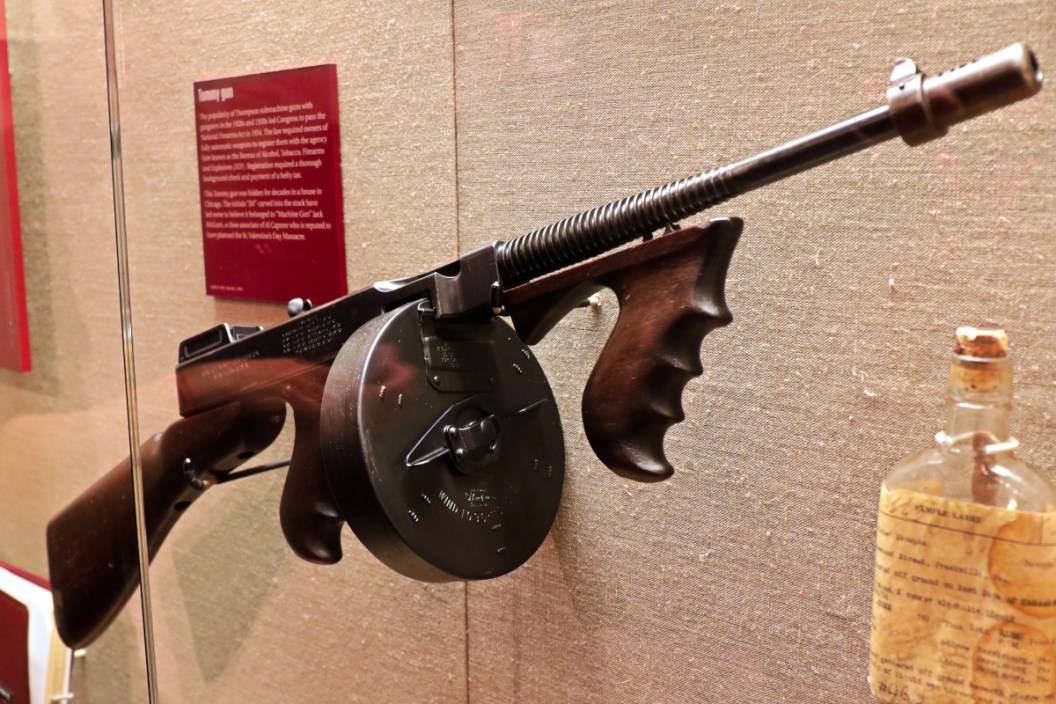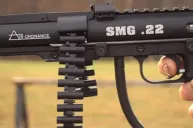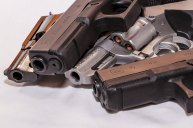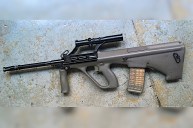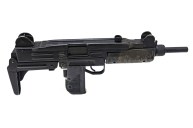Here's how the Thompson submachine gun became so famous and why it remains so to this day.
In the annals of firearms history, there are some guns that everyone, even non-shooting enthusiasts know from a simple glance. The Thompson submachine gun is one of those firearms. This iconic gun goes by a bevy of nicknames: "Chicago Typewriter," "The Annihilator," "The Street Sweeper," "Persuader," "The Trench Broom," and of course, "Tommy gun."
While this firearm has a storied history on the battlefield, including World War II, it earned a nasty reputation first as the firearm of choice for prohibition-era criminals during the roaring 1920s.
It's safe to say the Thompson changed the American small arms landscape completely as it led to some of the first heavy restrictions on the sale and possession of fully automatic weapons in the United States. Today, we'll look at the history and legacy of this fascinating firearm in depth and maybe even tell you a few interesting tidbits you've never heard about the Tommy gun.
The development of the Thompson submachine gun.
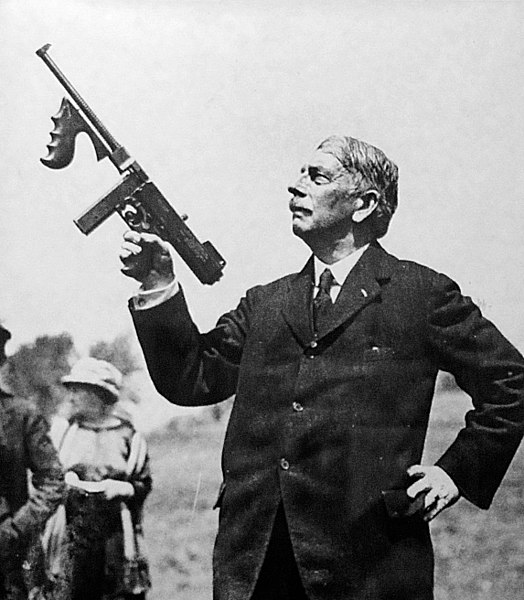
Wikimedia Commons: Jamie C
To understand the development of this iconic gun, it's important to know a little about the designer, John T. Thompson. A Kentucky native born in 1860, Thompson graduated West Point in 1882 and began a career in the U.S. Army shortly after. He served in the Spanish-American war before taking a position at the army ordnance department's small arms division.
In 1916, Thompson founded the Auto-Ordnance Corporation after locking down some investors. At this point, World War I had been raging in Europe for two years and the horror stories about the bloody trench warfare made Thompson realize the troops needed handheld automatic weapon to quickly and efficiently clear the trenches of enemy combatants. It seemed like a better option than bayonets or hand-to-hand combat, and Thompson wanted to be the one to provide that automatic weapon, which he originally envisioned as a rifle. The year prior he had become intrigued by inventor John Bell Blish's new breech locking mechanism known as the "Blish Lock."
The way it functions gets a bit technical. All you really need to know is that it's a form of blowback system, just clunkier than what you may be used to. There was just one problem, the Blish lock didn't work very well with rifle rounds, as Thompson had originally hoped. However, one of Thompson's engineers realized the system was perfect for the large, and hard-hitting handgun round .45 ACP.
This idea to use a pistol round happened at the tail end of 1917 and engineers with Auto-Ordnance started development on this new idea for a pistol caliber submachine gun right away. There was just one problem. By the time the first prototype Thompsons, which they nicknamed "The Annihilator," were done, World War I was over, and so was their intended market for the new innovative firearm.
The Thompson's early struggles.
On paper, the Thompson should have been a total failure from the start. Auto Ordnance renamed the Annihilator to Thompson submachine gun in 1919, but without the war to bolster sales, it was an uphill climb for the firearm. Auto Ordnance didn't have a place to build the Thompson, so they signed a contract with Colt firearms to mass-produce the first weapons in the line. An order of 15,000 Thompson Model M1921s was made even though Auto Ordnance didn't have that many customers. Never the less, they decided they would try for military, law enforcement and the civilian market. Yep, that's right. Some fully-automatic Thompsons with a 20-round box magazines were sold to civilians in 1921. It was a completely different era for firearms sales.
There was just one problem. The new M1 Thompsons were complex and not cheap to produce. It was Colt building them after all. Auto Ordnance's markup of the finished weapons meant a staggering $200+ price tag. That may not sound like much today but consider that a brand-new Ford Model T cost approximately $325 in 1921. The comparable price tag would be over $2,000 today. This was not a firearm that many people could afford and it was reflected in sales.
Sales of the Thompson were bolstered to some degree by some law enforcement, the US Marine Corps, and the United States Postal Inspection Service. A few hundred even managed to get shipped to Ireland, where they saw guerrilla-style combat at the end of the Irish War of Independence and the Irish Civil War. However, the first Thompsons did not have the reputation that they do today. In fact, many people were extremely critical of them. It was understandable given the huge price tag, the bulky 10-pound weight, and unwieldy muzzle climb that the earliest models had while shooting.
In response to some of those complaints, the M1921 A.C. was introduced by the Auto Ordnance Company in 1926. This version of the Thompson had the gun's now iconic muzzle break known as the Cutts Compensator. In 1928, some of the original 1921 Thompsons were modified into what is known as the 1928 stamp variant. These Thompsons were designed to have a lower rate of fire to make them easier to control. This was done at the request of the U.S. Navy, who liked the gun, but felt it needed some tweaking before it ever saw combat.
There were several other variants produced in the Thompson's early days that simply failed to click with both the military and civilian consumers. Of note here is the Model 1927, which was a semi-automatic variant that could utilize a 100-round drum magazine. There was also Model 1923, which was chambered in .45 Remington-Thompson, but the gun flopped and it's one of the rarer variants today.
The Thompson and organized crime.
Speaking of those 50-round magazines, in the mid-1920s the Thompson attracted some new fans in the seedy criminal underworld. Big cities like New York and Chicago were full of organized crime and the Thompson was famously used for both robberies and mob hits. The Thompson gave a huge advantage to the criminals robbing banks and bootlegging alcohol during prohibition. Gangsters loved the intimidation factor of the firearm and the Thompson's incredible rate of fire meant most police departments were completely outgunned. It was said that Bonnie and Clyde owned one, although it is well documented that Clyde Barrow preferred the Browning BAR in his crime sprees.
While the gun had developed quite the reputation already, February 14, 1929 would cement the firearm's legacy in 1920s gangster culture forever. This was the day of the St. Valentine's Day massacre. The incident, which happened on the north side of Chicago in the Lincoln Park neighborhood, saw seven men gunned down in cold blood. Five of them belonged to the North Side gang run by George "Bugs" Moran, a rival of Al Capone.
The killers used two shotguns and two Thompsons to riddle the victims with a hail of automatic fire. To the point that some of the victims were unrecognizable. The four killers have never been thoroughly identified, but most believe the massacre was a hit organized by Capone on his rivals. In any case, the two Thompsons used in the brutal killing eventually ended up in Michigan and are now owned by the Berrien County, Michigan Sheriff's Office where they are occasionally shot by law enforcement and brought out for public display for educational purposes.
The use of the Thompson in organized crime was impossible for law enforcement, FBI agents and the federal government to ignore. The St. Valentine's Day massacre was one of the driving forces behind the National Firearms Act of 1934 that most shooting enthusiasts know well. The NFA effectively put an end to most forms of civilian ownership of full-auto weapons today. It's why you see most firearms manufacturers building semi-automatic "civilian" versions of most of their popular automatic firearms today.
World War II and beyond.
John T. Thompson never got to see his gun in its most significant role with the armed forces. Thompson died in 1940 just after the start of World War II. The slow sales of the gun had already caught up to Auto Ordnance before this however and the company went bankrupt and was sold in 1939 following the death of one of the original investors. The new buyer, Russell Maguire, contracted Savage Arms to start producing new Thompsons in anticipation of high demand for the war effort.
He was right. Orders for Thompsons started pouring in from European countries who needed the extra firepower. Commandos in France and Great Britain were among the early recipients of these orders. The United States didn't enter the war until two years later in December 1942 after the Japanese attack on Pearl Harbor, but when they did, the Thompson was part of the equation.
Fortunately, the U.S. Military had adopted the Thompson back in 1938, so soldiers were already well trained in its use. The Army did quickly ditch the heavy, 50-round drum magazines made popular by gangsters in favor of 20 and 30-round box magazines that were lighter, easier to reload and made less noise in the field.
The Thompson had always been notoriously difficult to build, and the Army wanted the guns built faster and cheaper. Because of this request, Savage Arms built the M1928A1 variant. One of the biggest differences is the elimination of the wooden foregrip, simplified sights and the removal of the gun's signature barrel fins. The firearm is still instantly recognizable thanks to the pistol grip, wooden buttstock and receiver frame however.
The Army had also had enough of the Thompson's original Blish lock system that had brought the gun to the dance. This led to the development of the M1 and M1A1 variants. The biggest difference here is that the gun now had a straight blowback system and the charging handle was relocated from the top of the receiver to the side.
No matter which variant was used, the Thompsons were popular with troops in WWII. The firearm saw extensive use by paratroopers and Rangers. Usually it was Sergeants and Corporals that were issued the guns. Close quarters street fighting was where the weapon shined and solidified the gun's status as a legend in a whole new era.
Amazingly, the Thompson continued to see action in warfare beyond World War II, although not as often with U.S. Forces. The .30 caliber M1 Carbine becoming more favored by the Army since it weighed half as much as a Thompson and had a far greater range. Still, Thompsons saw action in the Korean War, Chinese Civil War, and the Vietnam War. They even saw action into the 1990s in the Yugoslav Wars.
The Thompson's legacy and modern versions.
It is safe to say that the Thompson submachine gun has firmly cemented a place in the history of modern firearms. It may be a mixed one since you have the criminal underbelly of society mixed in with the greatest fight for freedom ever in World War II. However, Auto-Ordnance is still in business today and they are STILL producing Thompsons.
Obviously, they are not the Hollywood-style full autos that made them famous, but it's still the same company. Auto-Ordnance now produces Thompsons in coordination with their parent company, Massachusetts-based Kahr Arms. Just like when they were first introduced, they come with a hefty price tag. Remember when we said the 1921 equivalent price would be around two grand? Well, modern Thompsons start around the $2,000 mark and go up from there.
The modern Thompsons are also classified as short barrel rifles or SBRs, which means buyers must pay additional fees to own them. Along with the Thompsons, Auto-Ordnance also produces 1911 pistols, M1 Carbine replicas and parts and accessories. It's safe to say the legacy of Auto-Ordnance will be alive and well for years to come thanks to their most famous firearm.
For more outdoor content from Travis Smola, be sure to follow him on Twitter and check out his Geocaching and Outdoors with Travis YouTube channels.
NEXT: 8 MILITARY SURPLUS GUNS EVERY SHOOTER SHOULD OWN
WATCH
